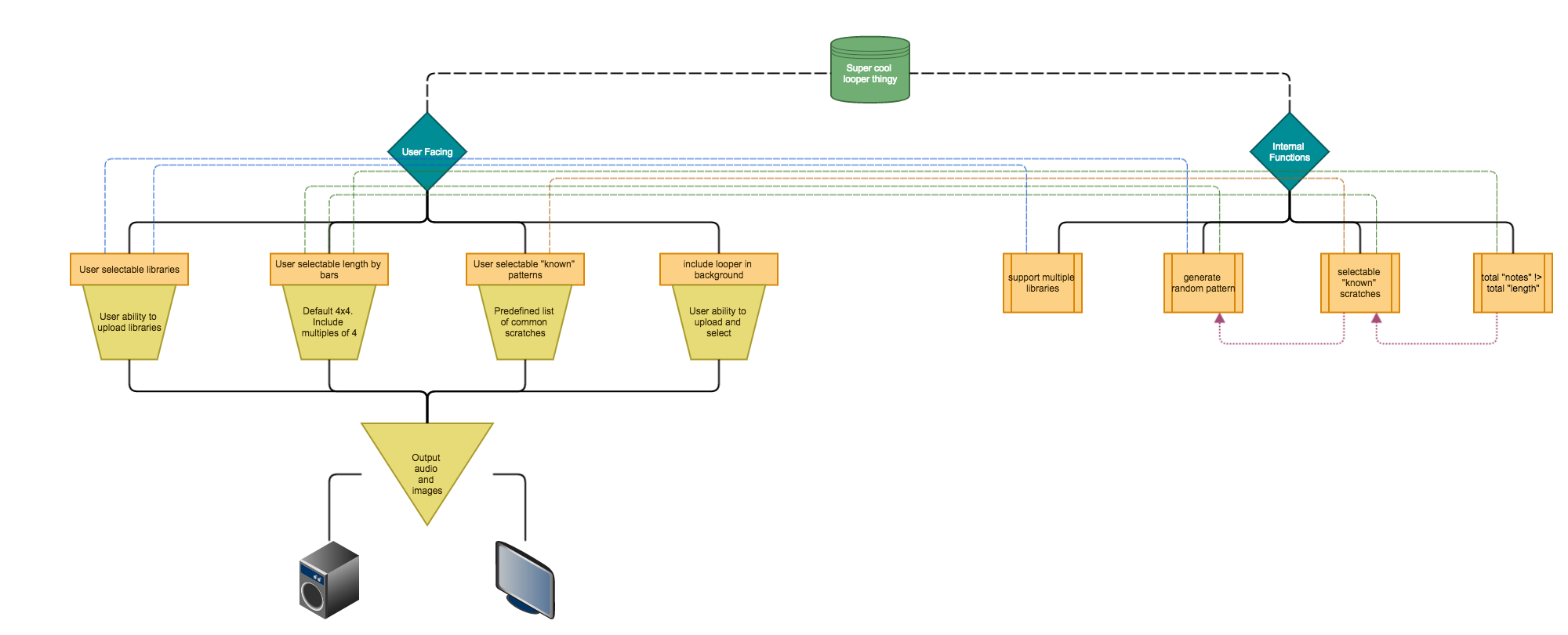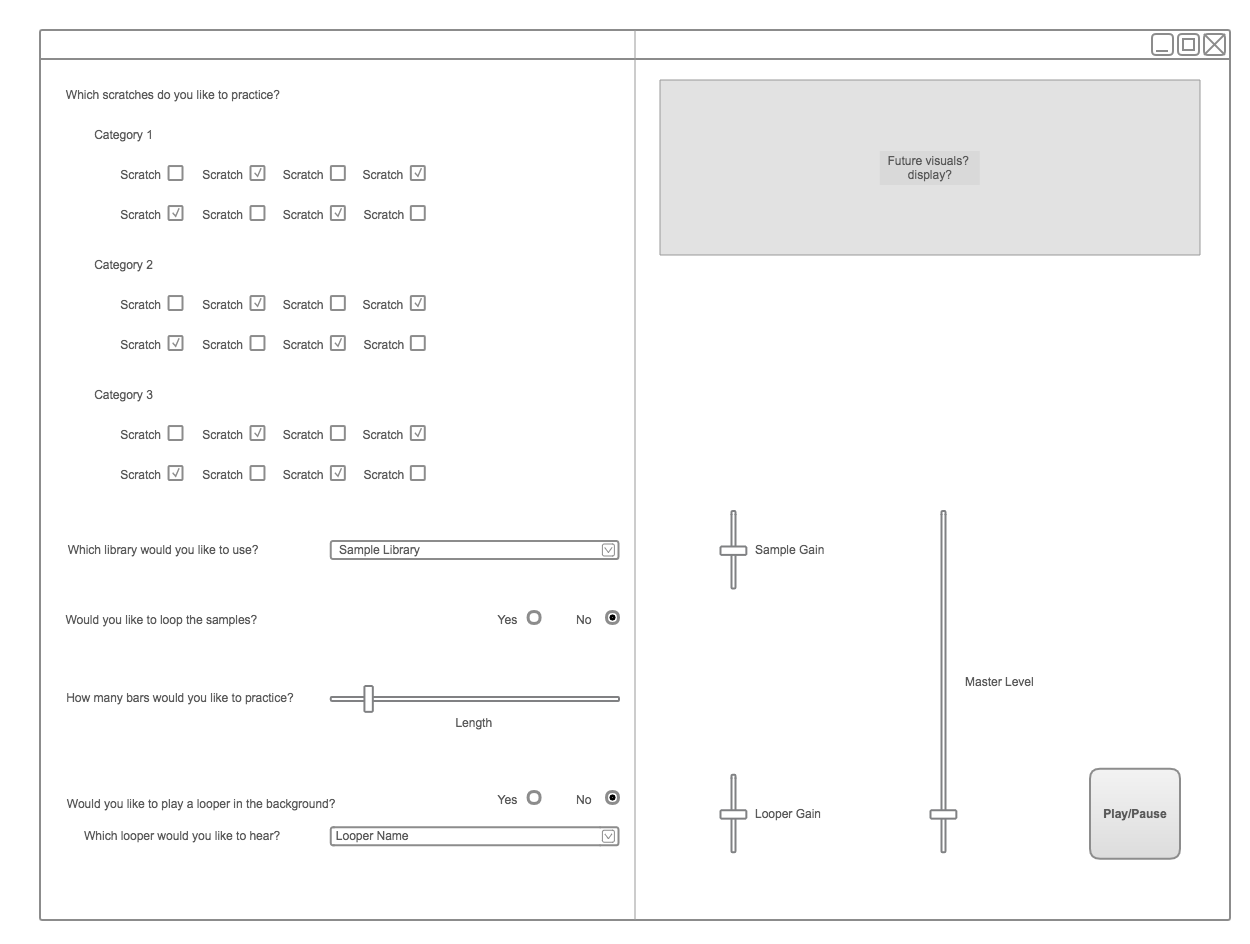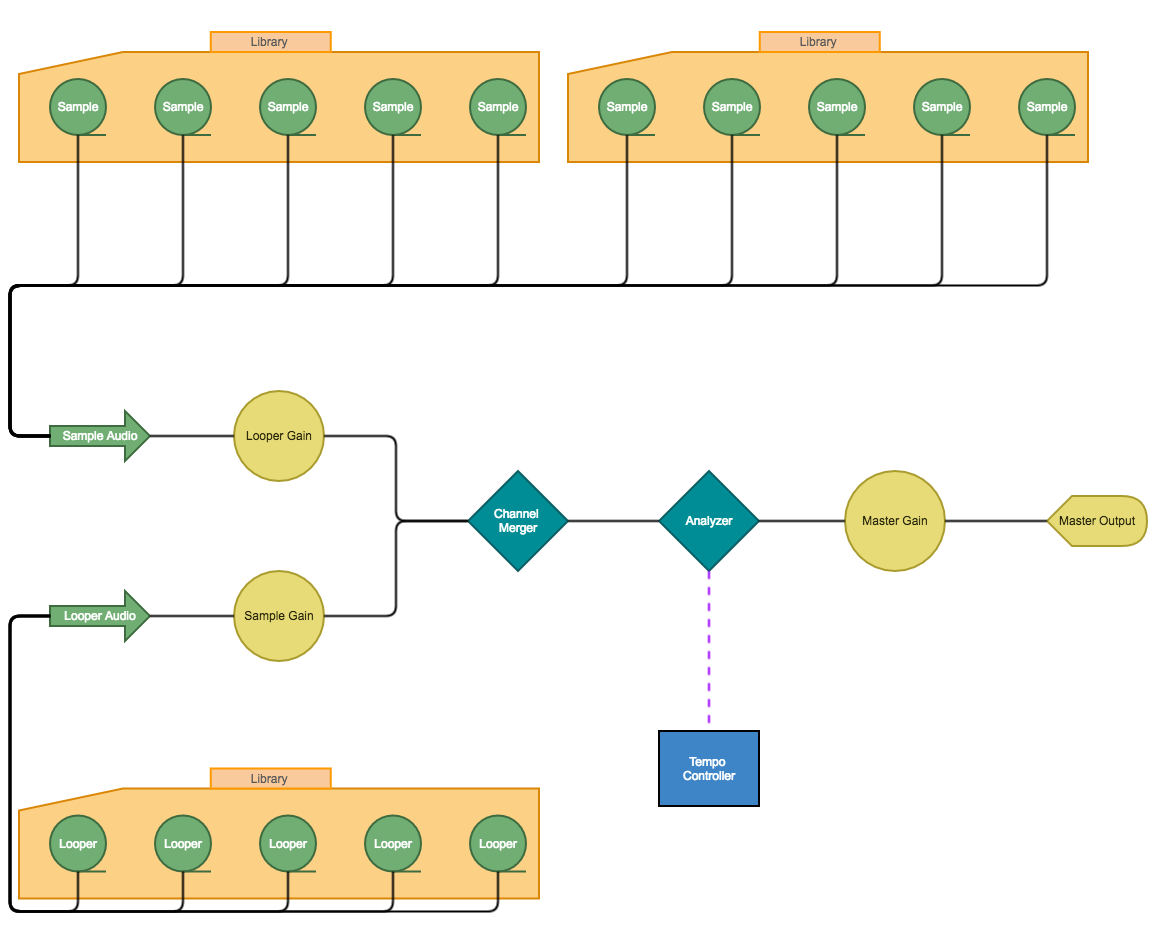-
Posts
111 -
Joined
-
Last visited
-
Days Won
2
Content Type
Profiles
Forums
Events
Posts posted by djlotus
-
-
My thought process is pretty similar to yours as far as functionality goes. You have some great ideas in there that I didn't think of such as a "silence" sample and Q & A mode.
The part is tripping me up, specific to the Web Audio API, is looping the generated scratch sentence. Each sample that is generated is linked as an audio buffer source node. These buffers are then sent to an array and randomized using the Fisher-Yates algorithm. From here it is no problem to play the sentence once. Unfortunately, audio buffers can only have the start() function called on them once which prevents the sentence from looping/playing again because once the sample plays through you cannot call the start() function again. I am trying to figure out a workaround but am coming up short.
I have looked into a process which which would concatenate the files associated with the array into a single file, but the same issue persists. I have thought about duplicating the array at the end of playback so a new array is available to play every time but I'm not sure what effect that will have on performance.
-
I posted a light proof-of-concept at http://www.heyimjames.com/combo-thing/index.html
-
hey guys. sorry to hijack the thread but I have a serious problem. buddy of mine installed of these JD faders per specs on the vid. while doing so, possibly busted a resistor. We replaced the resistor, but still no dice. The fader, and the switch, now don't do shit. any suggestions. My boy needs this shit to work and doesnt want to ship to the other coast just so dude can "maybe" look at it. Thanks in advance.
-
Sounds great Deft.
I've made some good progress the past few days. Web Audio API is a bit limiting so I am having to find work around's for a few things such as managing the sample libraries and creating a faux "reset" function. I'm updating the Wikis on the repo every few days with my thoughts and discoveries if you want to see how I am going about everything.
Handling the actual audio is going to be the biggest problem. I have it set up now so you select the sample library you want to use, choose if you want to include a background looper, and then select the looper you want to include. Obviously more functionality needs to be added (tempo, repeat, recording etc.) but, I have broken the functionality into modular parts and will build one by one and add to it as I go.
I do have some questions about the samples/sample libraries if you want to give me some guidance:
- When recording the samples I was thinking of recording them at 120 BPM. I think that tempo will make it easier to apply quantizing and swing in the future and make the timing functions easier overall.
- Regardless of the recorded BPM, should all samples be recorded at 1 BPM? For example, at 120 BPM a baby would be 0.5 seconds long. Should all scratches be recorded at that length? That could cause serious timing/audio issues if the pattern were " baby, 2-click-forward, reverse stab, baby, forward-tear." Maybe this is the way to go and we can adjust the tempo on a per sample basis. (I'm thinking of creating objects for each sample type and tying extra info to them in JSON format. Could store tempo adjustments and anything else we needed on the object and just reference it from there when needed).
- I am progressing right now with a system that (basically) creates nodes for each scratch sample and then plays them end to end.
bufferArray[0].start(); bufferArray[0].onend = function() { bufferArrray[1].start(); }and so on). The buffer objects are incredibly light and trash collected quickly so performance is not an issue. I am exploring whether it may be better to take take the samples individually and concatenate them into a single file at runtime and use a marker in the head to jump from sample to sample. Thoughts? - I just learned that when exporting .MP3 0.26s of empty data is added to the beginning and end of the file. I wonder if this will impair the looping functionality?
I could on for hours.
Below are some crude flow diagrams of functionality and such. The one with the controls on it isn't meant to be a reference for layout. It's just a visual to keep track of what controls will be needed.
Let me know what you think:



-
 1
1
-
Sorry if this is in the wrong place but wanted to start a new thread related to http://www.digitalvertigo.co.uk/forum/index.php?showtopic=1385&view=getnewpost.
I'm not sure how practical it is but, I've decided to try to make a browser-based version of Sideshow's combo generator. I was too late to actually see it work (Windows 7) and non of the file links work anymore so I'm basically taking the idea and starting over. I have lots of questions for anyone who go to play with the program.
I've preliminarily decided to build it with the Web Audio API and Canvas API. I could use all the help I can get. I set up a repo at https://github.com/djlotus/combo-gen and for real-time discussion I set up a Gitter at https://gitter.im/combo-gen/
I'd love to open the discussion here about it.
If I'm over-stepping my bounds by bringing this back to life let me know and I kill the project.
Thanks everyone.
-
 1
1
-
-
I created a repo at: https://github.com/djlotus/combo-gen. Nothing is there content wise. Just threw together a little ReadMe and a couple crude flow charts for now. Plan is to use NPM and Gulp to manage the build so the parts can be built separately and compiled in the build process. An easier workflow for me personally.
-
I wish I had gotten my hands on the original so I could piece together specifics to answer some questions I have about it.
- Do all of the scratch patterns in each sample pack use the same sample?
- Was it tempo dependent?. i.e. All samples recorded at x tempo, but tempo is adjustable in program?
- Were scratch patterns able to be quantized to lower than a whole note?
- Was there an option to play a looper in the background?
- Was there an option to loop the scratch sample?
- Was it possible to record your scratch input?
- Should any form of notation be included as well?
i guess these aren't vital questions if building from the ground up but would be good to get an idea of everything it did/didn't do. Would also help to gauge the feasibility for me to design and build this thing.
-
I may give building a browser version of this a try. Would take a while but could post on GitHub for collaboration.
-
 1
1
-
-
Love watching stuff like this.
-
You are right Jam. The only IC on the bottom board. Found some 6x and 8x replacements but no 54 pin. Got a 61 today.switched out the plastic fader carriers for the metal ones in the 56 and I'll just part out the rest.
-
'Im pretty sure, at this point, the problem is in the micro-controller. I have tested for proper control voltage at every regulator, diode, op-amp, etc. I even have the proper voltages at the inputs to the mc. It appears the audio signal is fed through the mc, out to the faders, back to the mc, and out to all of the output channels. The mc they used is now obsolete and I can't find a 54 pin replacement online.
I will be parting this mixer out. Thanks for you help everyone. I didn't fix it but, I did learn a bit.
-
Ill be ready to part it out as soon as the new mixer gets here and I can verify it works as it should. Hopefully middle of next week.
I would prefer to just send the entire board to you and let you use that or pull parts off you need. I'll let you know as soon as I'm ready to go.
-
I grabbed a 61 off ebay. If you have issues finding the pots you need let me know. I'll probably be parting out my 56.
-
Got outbid. Not willing to drop more than $75 on a busted mixer in that terrible condition.
-
I've traced the circuit as far as I can keep up with the diagrams. Good voltage as far as I can tell. All the caps pass the eye test but, the more I try to make sense of the circuitry, the more I realize it's beyond my abilities.
I've been very careful not to make things worse. I'm thinking now I'm going to ship it to someone to look at it.
I love tinkering and learning, but this is a problem best left to professionals. I just hate having to pay a hefty price tag to get it fixed. Have to decide now if I want to spend the loot to get it fixed or put that cash towards a new mixer. I'm really going to miss those faders if I get a new mixer.
-
I changed the batteries in my meter and it seems to have helped. I now have +5v out of Q3, +15v out of 10A, and -15v out of 10B. Now I'm trying to trace the circuits around the boards to see if I notice anything wrong elsewhere.
-
If it was me I would probably take it someone who can actually diagnose and repair with some precision. If you replace the transistor and that doesn't work you still want to shotgun the repair then you might try replacing the caps in the power supply. I don't think it's all that uncommon for those caps to fail (happened in my 54 and Chris at Rane told me it's a pretty common thing.) I hate to suggest shotgunning the fix but if you're going to, caps are a good place to start. I almost never hear about resistors going bad.
Are you referring to caps in the transformer casing or the the caps in the power supply circuits?
Def some food for thought. I'm trying to work through it on my own (read: not pay for repair) for a little education. I'm pretty handy with things like this so I love learning. This has me a bit baffled though. I am trying to avoid paying to get fixed simply because of the cost associated. There are only a few reputable places within 60 miles from me. All have a minimum $75 drop off/diagnostic fee and average $90-100 per hour for repair. I would guess the least it would cost would be $250-$350. I have plans to buy a new mixer if I can't fix this one soon so this will be a project I work on until it's done. I'll replace every part on the board eventually if I have to.
-
I'll verify when home. It's always a possibility. I am also picking up a nte1929 in hopes that I can use it to replace the lm317 voltage regulator if needed. Only regulator I can find in stock without having to purchase online. Looks like if all the caps and resistors are still good, this regulator should work fine.
-
Any chance you want help me a bit more troubleshooting this thing rasteri? You knowledge far surpasses mine.
Should I start by replacing the voltage regulator given the voltages I stated in above post?
-
I've got a bid on a busted 56 on Ebay right now. If I can see if anything is good enough to reuse. Ill probably get auction sniped at the last second though.
-
Sounds like you have a problem on the 5v power rail. Check the 5v regulator (Q3 on the bottom PCB).
(btw, here's the full ttm56 schematic with the pages missing from the one on the rane site - https://drive.google.com/open?id=0B7FEmphzxtnxdW5CWkllTGZJNEU )
Well, I have checked the board. Not sure how familiar you are with with what voltages should be present and where. I have 9v present on both sides coming from the transformer. That makes sense because its a 18vct. When I get to the 5 volt regulator and I have 2.5v to the input, 0 to output, and 0 to adjusted. Not sure how to tell if that's wrong. I think it is since that circuit is supposed to have 5v once it continues past resistor 384. Another thing I'm noticing is that the other regulators are registering 0 volts on all three pins. I am measuring everything to the line side of the common circuit inducer.
Not many answers there I can figure out. Any more ideas?
-
Just started. I actually just came back to the board after a few years absent so was thinking that may have had something to do with it. It's not a big deal. I don't mind checking in. Just thought you should know. Thanks!
-
sorry can't be of much help here but taking notes for the future

I'm constantly on the look out for parts so if I come up with anything Ill let you know.
I'd appreciate that and I will do the same in return.
I just got home so I'm going to be digging into this. I'm going to start with the power supply and work my way in.
-
FYI. Pretty sure my settings are correct but I am not receiving emails for followed threads. Checked in spam folders as well and found nothing.



DMC ONLINE 2017
in MUSIC/DJ RELATED
Posted
Not familiar with this guy so I was expecting a lovely train wreck. I was happily wrong. Not my favorite sound but damn that dude is precise.